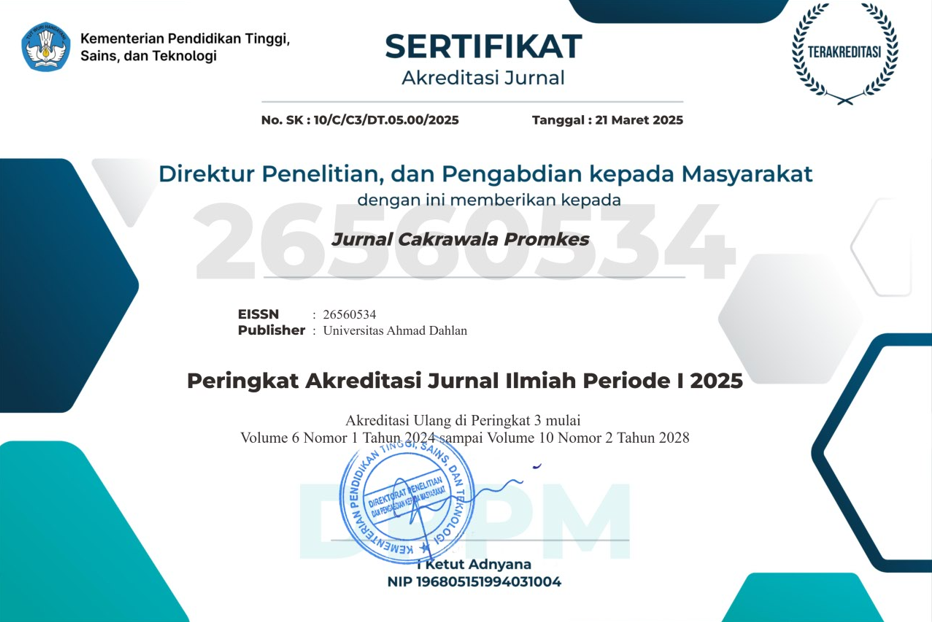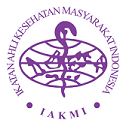Faktor-faktor yang berhubungan dengan pemanfaatan pusat informasi dan konseling remaja (PIK-R) pada remaja di SMA N I SInden
DOI:
https://doi.org/10.12928/promkes.v1i1.291Keywords:
PIK-R utilization, knowledge, attitude, role of peer educatorAbstract
Background: Teenagers have a very complex problem along with the transmission period they experienced. In general, adolescents expressed the need for reproductive health services that is equal to 94.55% of the total respondents. Only a few respondents stated that they had used a youth service center that was 23.42%. Utilization of Youth Information and Counseling Center is still very low in Indonesia. Strategies to improve the utilization of the Youth Information and Counseling Center are urgently needed. This study was conducted to determine the relationship between knowledge, attitudes and role of peer educators with the utilization of PIK-R in adolescents in SMA N 1 Sanden.
Method: This research is a quantitative analytical research with cross sectional approach. Sampling using purposive sampling technique and obtained a sample of 75 members of PIK-R in SMA N 1 Sanden. Measurement of variables using questionnaires and tested using Chi square test.
Results: The results of this study indicate that the role of peer educators has a significant relationship with the utilization of PIK-R (p = 0.008), no knowledge relation (p = 0.218) and attitudes about reproductive health (p = 0.072) with PIK-R utilization. Peer educator role variables have RP = 2.323 (95% CI = 1.284-4.202) more than the number 1 means peer educator role is really risk factor. Knowledge and attitude variable have RP value = 0.590 (95% CI = 0.278-1.252) and RP = 1.798 (95% CI = 1.029-3.143). Conclusion: There is a significant relationship between the role of peer educators and the utilization of PIK-R in adolescents in SMA N 1 Sanden.
References
2. Kusmiran, E. 2011. Kesehatan Reproduksi Remaja Dan Wanita. Jakarta: Salemba
3. PKBI. 2011. Kebutuhan akan Informasi dan Pelayanan Kesehatan Reproduksi Remaja Laporan Need Assesment di Kupang, Palembang, Singkawang, Cirebon dan Tasikmalaya. Jakarta : PKBI, UNFPA & BKKBN.
4. Rahayu, Y. S. 2014. “Faktor – Faktor yang Berhubungan dengan Pemanfaatan Layanan Pusat Informasi dan Konseling Kesehatan Reproduksi Remaja (PIK – KRR) Kelurahan Jatingaleh Kecamatan Candisari Kota Semarangâ€. Skripsi, Universitas Diponegoro, Semarang, Tidak diterbitkan
5. Satiti, O. P. 2017. “Faktor – Faktor yang Berhubungan dengan Pemanfaatan PIK – KRR Studi pada SMA, SMK, MA SeKabupaten Patiâ€. Tesis, Universitas Muhammadiyah Semarang, Semarang, Tidak diterbitkan
6. BKKBN. 2014. Data PIK – R/M, Pendidik Sebaya (PS) dan Konselor Sebaya (KS) Daerah Istimewa Yogyakarta : yogya.bkkbn.go.id diambil pada tanggal 13 Oktober 2017. Yogyakarta
7. Profil sekolah
8. Sulistyaningsih. 2011. Metodologi Penelitian Kebidanan. Yogyakarta : Graha Ilmu
9. Budiman & Riyanto, A. 2013. Kapita selekta kuesioner pengetahuan dan sikap dalam penelitian kesehatan. Jakarta: Salemba Medika
10. Kusumastuti, D. P. 2016. “Hubungan Pengetahuan dan Sikap Tentang Kesehatan Reproduksi dengan Pemanfaatan Pusat Informasi Dan Konseling Kesehatan Reproduksi Remaja (PIK-KRR) di SMA Negeri 1 Srandakanâ€. Skripsi, Universitas Gadjah Mada, Yogyakarta, Tidak diterbitkan
11. Rustika, D. R. 2014. “Faktor – Faktor yang Mempengaruhi Pemanfaatan Pusat Informasi dan Konseling Kesehatan Reproduksi Remaja (PIK-KRR) pada Remaja SMA Negeri 5 Yogyakarta Tahun Ajaran 2014â€. Skripsi, Universitas Aisyiyah, Yogyakarta, Tidak diterbitkan
12. Yansah, F. 2011. Peran Peer Educator Remaja Dalam Pemberian Informasi Kesehatan Reproduksi Remaja. Bandung : Alfabeta
13. Saito, K. 2009. Performance of Peer Educators on HIV/AIDS Prevention Among High School Students in Bangkok Metropolitan Thailand. Jurnal Maternitas dan Neonatal. Vol. 1, No. 58, Hal. 1-12
14. Kurniawati, H. F. Shaluhiyah, Zahroh. 2014. Pengetahuan Pendidik Sebaya Mempengaruhi Pemberian Informasi KRR di Kabupaten Kulon Progo. Jurnal Promosi Kesehatan Indonesia. Vol. 9, No. 2, Hal. 162-172
15. Afrima, A. 2011. Akseptabilitas dan Pemanfaatan Pusat Informasi dan Konsultasi Kesehatan Reproduksi Remaja (PIK-KRR) pada siswa SMU Di Kota Bima NTB. Universitas Gadjah Mada,Yogyakarta.
16. Notoatmodjo, S. 2011. Kesehatan Masyarakat. Jakarta: Rineka Cipta
17. Notoatmodjo, S. 2014. Ilmu Perilaku Kesehatan. Jakarta: Rineka Cipta
18. Priyoto. 2014. Teori Sikap dan Perilaku dalam Kesehatan. Yogyakarta: Nuha Medika 19. Marmi. 2014. Kesehatan Reproduksi. Yogyakarta : Pustaka Pelajar.
Downloads
Published
Issue
Section
License
Copyright (c) 2018 Vichi Fadzilla, Sitti Nur Djannah

This work is licensed under a Creative Commons Attribution-ShareAlike 4.0 International License.
Authors who publish with JCP: Jurnal Cakrawala Promkes agree to the following terms:
- Authors retain copyright and grant the journal the right of first publication with the work simultaneously licensed under a Creative Commons Attribution License (CC BY-SA 4.0) that allows others to share the work with an acknowledgement of the work's authorship and initial publication in this journal.
- Authors are able to enter into separate, additional contractual arrangements for the non-exclusive distribution of the journal's published version of the work (e.g., post it to an institutional repository or publish it in a book), with an acknowledgement of its initial publication in this journal.
- Authors are permitted and encouraged to post their work online (e.g., in institutional repositories or on their website) prior to and during the submission process, as it can lead to productive exchanges, as well as earlier and greater citation of published work.

This work is licensed under a Creative Commons Attribution-ShareAlike 4.0 International License












